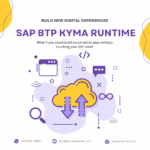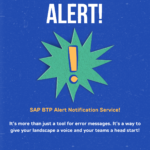Why do businesses need to get better at listening to their systems?
In today’s digital-first world, the systems we build are only as strong as our ability to hear them when they whisper—before they scream.
Organizations pour time, effort, and money into building scalable, intelligent enterprise applications. But when it comes to monitoring them—really listening to them—most fall short. Alerts get buried, teams react too late, and customers feel the impact before you do.
This is where SAP BTP Alert Notification Service becomes the silent hero of enterprise stability. It doesn’t just inform you when something breaks. It tells you when something might break. It enables teams to shift from a reactive firefighting mindset to a proactive, empowered one.
Let’s dive into what makes SAP BTP’s Alert Notification Service such a critical piece of your operations, and how to implement it with purpose.
What is SAP BTP Alert Notification Service?
At its core, the SAP BTP Alert Notification Service is a central communication mechanism that lets you define events across your SAP landscape—and decide who should know about them, how, and when.
Think of it as a highly configurable, rule-based engine for delivering system alerts through channels your teams already use: email, Microsoft Teams, Slack, SAP Solution Manager, or even custom webhooks.
Whether it’s a failed integration flow, a threshold breach, or custom-defined business conditions, the service ensures the right people are notified instantly.
Why does this matter?
Because in enterprise environments, delay is expensive.
Every minute of unplanned downtime costs money, credibility, and productivity. What if your finance workflows stop posting journal entries? What if your order processing integration fails silently overnight?
Traditional monitoring solutions generate logs and dashboards. The Alert Notification Service goes further—it brings context to you, when and where it matters most.
Key Use Cases: Where Alert Notification Service truly shines
1. Integration Flow Monitoring in SAP Integration Suite
Integration scenarios are the lifeblood of connected systems. But integration flows fail. Maybe due to a timeout, bad credentials, or system outages.
Use Case: Configure alerts for specific integration flows in SAP Cloud Integration. For example, if an iFlow fails 3 times in a row, notify your DevOps team via Slack with error metadata.
2. HANA Memory Utilization Breach
HANA is powerful—but memory constraints can cripple performance.
Use Case: Set up thresholds for memory utilization in your SAP HANA Cloud environment. If usage goes beyond 85%, send alerts via email and Teams before the application slows down.
3. User Authentication Failures
Security breaches often start with anomalies in login behavior.
Use Case: Configure custom alerts to track multiple failed login attempts on SAP BTP apps. This allows your security team to investigate before it escalates.
4. Custom Business Events
Not all alerts are technical. Sometimes, you want to know if a business rule is broken.
Use Case: Set up a custom webhook to send an alert if a large sales order (say over $100,000) is entered outside business hours, ensuring compliance and risk visibility.
How to Set Up SAP BTP Alert Notification Service (Step-by-Step)
Let’s break this down simply.
1. Access the Service:
Go to your SAP BTP cockpit and subscribe to the “Alert Notification” service in your global account.
2. Create a Condition:
Define what triggers the alert.
- Example: “iFlow status = FAILED” OR “CPU Usage > 80%”
3. Create an Action:
Decide how to communicate it.
- Example: Send email to devops@yourcompany.com or post to a Microsoft Teams channel using a webhook.
4. Create a Subscription:
This links conditions and actions. You can also add filtering logic to prevent noise.
5. Test It:
Trigger a known failure (or simulate one) and verify alert delivery.
Done. You’ve now given your system a voice—and made sure the right people are listening.
Best Practices for Using SAP BTP Alert Notification Service
- Keep It Actionable: Avoid alert fatigue. Every alert should inform and empower action.
- Segment by Teams: Route alerts by relevance. DevOps, Security, and Business teams should only get what they need.
- Use Rich Metadata: Include payloads, timestamps, and error codes in alerts to reduce troubleshooting time.
- Integrate with ITSM Tools: Use integrations with ServiceNow or Jira to create incident tickets automatically.
- Review Regularly: Business systems evolve. Make reviewing alert rules part of your monthly health check.
Real-World Example: A Finance Team’s Quiet Save
A multinational firm using SAP S/4HANA and SAP Integration Suite was unknowingly failing to post vendor invoices from a third-party scanning tool due to an API token expiration.
With SAP BTP Alert Notification in place, a triggered alert notified the Finance lead in real-time. Within minutes, the token was refreshed, and hundreds of pending invoices were processed—without Finance even knowing they were in danger of missing payment SLAs.
So what does this mean for you?
If your SAP BTP landscape is already smart, SAP BTP Alert Notification Service is what makes it aware. It’s the difference between monitoring your systems and understanding them.
And more importantly—it’s the difference between reacting and responding with intention.
Final Thoughts
Technology doesn’t fail us quietly. It always leaves breadcrumbs.
Your job isn’t to chase them. It’s to make sure you hear them as soon as they hit the floor.
By implementing SAP BTP Alert Notification Service, you give your system a voice, your team clarity, and your business the power to move fast without breaking things.
Because in enterprise landscapes, silence isn’t golden—it’s dangerous.











